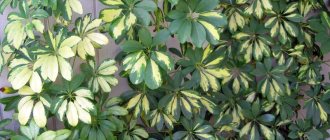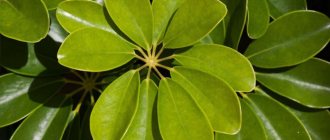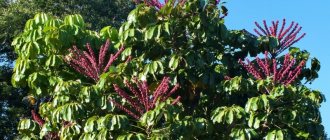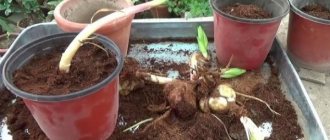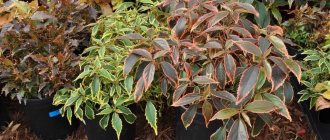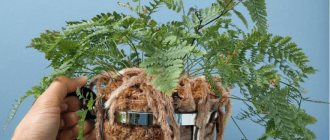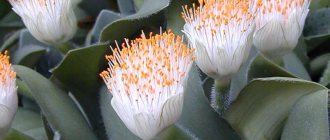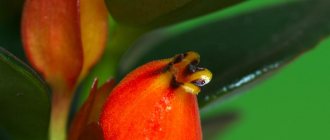- home
- Plant catalog
- Decorative foliage
Reading time: 11 minutes
27363
The Schefflera plant is named after the German botanist Scheffler and is part of the Araliaceae family. Ginseng and ivy are also members of this family. Schefflera is a plant of the tropics and subtropics ; in its homeland it is considered quite aggressive, displacing other crops. But the shefflera flower is very beautiful.
Here it has become a popular houseplant and is recognizable by its palmately compound leaves.
There can be from 5 to 18.
The leaf blade itself, depending on the type, can be narrow, rounded, jagged and wavy.
There is a wide variety of forms that are united under one name. There are several hundred species of it.
- Types of Schefflera Schefflera tree-like, or woody
- Schefflera radiata
- Schefflera eight-leaved
- Schefflera the most graceful
- Scheffler Veitch
- Schefflera palmata
- Schefflera business
- Watering
Types of cheflera
Schefflera Mix, that is, a mixture, is popular among beginning gardeners.
These are the most unpretentious varieties that are readily purchased.
For example, trees with gracefully intertwined trunks are Schefflera Compacta intertwined. Small-sized indoor plants, such as Schefflera Moondrop (Moondrop), remain favorites.
Schefflera arborescens, or woody
Schefflera arboreal in its homeland in Taiwan grows as an evergreen bush, up to 4 meters high. The leaves have from 7 to 9 plates. It is distinguished by the unpretentiousness and beauty of the variegated varieties of this species.
Woody Schefflera is also grown as a bonsai.
A miniature form like Caster looks good. If you have little space, but want to have this particular plant, then the Caster variety is your option. Small in size, 20-30 cm, it will decorate any interior: home or office .
One of the low-growing varieties is also Schefflera Melanie, a graceful variety with small leaves. It does not grow above half a meter.
And Gold Capella, one of the tree-like varieties, is distinguished by its leaves: on a dark green background there are bright golden strokes and spots.
Based on Schefflera woody, the Schefflera Charlotte variety was also recently developed with bright green leaves with white spots, leathery and shiny - a favorite of landscape designers.
Schefflera radiata
Schefflera radiata (or star-leaved) grows in its homeland in Australia as an epiphyte, that is, on trees. It has many aerial roots. In nature, its height is about 12 meters, and the leaf plate can reach 60 cm.
As an indoor plant, the plant grows 60-80 cm, then growth slows down. Radiant varieties are very decorative. Its leaves can be olive, light green in color, and have a finely toothed shape.
Schefflera eight-leaved
Schefflera octophyllum is known in Asian countries. There it grows like a bush or tree, its height is 2-16 meters. The leaves, according to the name, are crowned with a rosette of 8 plates. They are very beautiful, leathery and glossy.
They come in different shapes, depending on the variety: from oval to ellipse, 7-15 cm in length. Sometimes it is called eight-leaved.
Schefflera the most graceful
Grows in Australia and New Zealand. In nature it reaches 2 meters and is distinguished by its lush green mass with a small number of stems. In indoor conditions it is much smaller than other species; in adulthood it has a height of 50 cm.
This elegant species has interestingly shaped leaves: elongated to oval, serrated along the edges. Some varieties have beige edging.
Scheffler Veitch
Known for the reddish hue of its leaves when young. Over time, the leaf changes its color to normal. The leaf shape of this species is very unusual: a wavy leaf plate, jagged along the edge, a real decoration for a home or office.
Veitcha is a rather rare species, and due to its decorative nature it does not linger in flower shops.
Schefflera palmata
Schefflera digitata in its homeland, New Zealand, grows more than 3 meters in height, as a houseplant - 60-70 cm. The leaves are dissected, like all types of schefflera. Depending on the variety, it has from 7 to 14 leaf blades, slightly wavy.
The edge has an interesting shape: from feathery - in youth, to jagged - in adulthood. The most shade-tolerant of them, Schefflera Amate, belongs to this species.
Schefflera business
Its homeland is the forests of Western China. The height in nature is 2-3 meters. The leaves are very beautiful, the plate resembles an oak leaf. As a houseplant - quite squat, about half a meter. Prefers a little shade, otherwise this species is grown in the same way as others.
Description
Schefflera (or Schefflera) is native to many countries with tropical climates. In nature, it grows in the form of a tree or shrub. There are species that reach a height of forty meters. These species are not suitable for indoor breeding. Many specimens in nature have more modest sizes, reaching two meters. In indoor conditions, the plant can reach one and a half meters. Therefore, the plant can be more often found in spacious halls, offices, and winter gardens. If space allows, then Schefflera can be successfully grown in an apartment, you just need to take into account its rapid growth.
It belongs to the Araliaceae family, and about 400 species grow in nature. The plant got its name from the name of the famous botanist Jacob Christian Scheffler from Germany. It is characterized by umbrella-shaped leaves, consisting of several dissected lobes. The number of lobes on a leaf ranges from 4 to 12, depending on the variety. The leaves are located on long petioles.
In nature, the plant blooms with inconspicuous small white flowers collected in an umbrella. It is not possible to achieve schefflera flowering indoors, but this does not upset flower growers. Because decorative leaves more than compensate for the lack of flowers.
Lighting
The plant should be protected from direct sunlight in summer , otherwise burns in the form of yellow spots will occur.
And at the same time, the north window is contraindicated.
The best option: southeast or southwest.
When the sun is very strong, you need to move the pot deeper into the room.
In winter, the best option would be a south window.
Advice : Schefflera loves the sun, so a north window is not an acceptable option for her. But it must be protected from direct sunlight.
Shefflera pot
Having prepared the soil mixture, you should choose the right pot for the plant. Here everything will depend on the age of the plant. For example, small pots or even plastic cups are suitable for seedlings.
But when the roots grow, they should be transferred together with a lump of soil into pots with a diameter of 9 centimeters, and in the fall they should be transplanted into pots with a diameter of 12 centimeters. With each subsequent transplant, the diameter of the pot must be increased by 3–5 centimeters.
Temperature
Temperature conditions are very important for shefflera. The most comfortable temperature for her will be 15-20°, in winter you need to make sure that the temperature does not fall below 12 degrees , the limit is 10°. Otherwise, the roots begin to rot.
You won’t notice this right away, but over time the process will spread to the above-ground part of the plant. When the stem rots, it becomes soft and the leaves may turn black.
Watering
Watering should be moderate. The soil should not be too damp, but only damp. Temperature and water quality are of great importance. It is better if the container of water sits next to the pot.
Carefully! Watering with cold water promotes root rot.
Fertilizer
The plant is fertilized from March-April to October-November, that is, during the period of active growth. In winter, the plant needs to rest. It is best not to reinvent the wheel, but to feed it with mineral fertilizer 2 times a month or once every two weeks.
Transfer
The Schefflera is replanted as the container is filled with roots.
You can find out by taking out a soaked lump of earth with roots.
There is another option: watch an adult plant, when the roots entwine the ball, the soil dries out faster than usual.
It needs to be replanted into a larger pot. Moisten the soil a little, replant, being careful not to damage the roots, then add more soil. When transplanting, you can use Kornevin.
Schefflera in winter
In winter, shefflera should rest . To prevent her from stretching out, create comfortable conditions for her. Temperature 14-16 degrees, moderate watering, fairly bright lighting and no fertilizing.
Attention! Despite the fact that she loves spraying, in winter it is enough to spray the plant 1-2 times a week.
Rules for caring for shefflera at home
Schefflera is unpretentious when grown indoors. But there are simple maintenance rules that will ensure the beauty and long life of the plant.
Lighting
Since the sheflera needs diffused light, the best place in the apartment will be the window sills of the eastern and western windows. On northern windows you can place Schefflera species with single-colored green leaves. In summer, it is recommended to take the pot with the plant to the balcony or loggia, but be sure to shade it from direct sunlight and protect it from drafts. In autumn and winter, the flower needs additional artificial lighting, especially when the room temperature is above eighteen degrees.
Temperature
Although Schefflera comes from the tropics, it does not like high temperatures. In summer, the ideal temperature for her would be twenty degrees Celsius. If the weather is very hot, the flower may shed its leaves.
In winter, the optimal temperature is in the range from fourteen to eighteen degrees. If the plant remains in a room with central heating in winter, then it is necessary to protect it from the dry warm air of radiators.
How to water
Schefflera prefers moist soil without drying out or waterlogging. Therefore, special attention should be paid to the regularity of watering. In summer, watering is carried out approximately once every two days, after the top layer of soil has dried. But at the same time, you need to water moderately to prevent stagnation of water in the soil. Stagnation of water leads to rotting of the roots. For irrigation, use only settled water at room temperature so that the temperature of the soil in the pot is not lower than the air temperature.
Schefflera prefers high ambient humidity. You can place the pot with the plant on wet expanded clay. Spraying is carried out every two days in the summer. Water for spraying should also be settled and warm. When kept in a room in winter, they also continue to spray or wipe the leaves with a damp sponge.
Top dressing
Regular, timely feeding promotes the growth and health of sheflera. Liquid complex fertilizers for decorative deciduous indoor plants are suitable for it. From spring to late autumn, sheflera is fed twice a month. You can feed with organic and mineral fertilizers, alternating them.
Important! It is not recommended to feed the flower with dry fertilizers.
The soil
Schefflera prefers light, nutritious, slightly acidic soil. To prepare it yourself, you need to take the following components:
- leaf soil (30%);
- turf land (40%);
- humus (20%);
- sand (10%).
This may be interesting: Yucca - reproduction, diseases and pests
You can prepare a soil mixture from turf soil, humus and sand, taken in a ratio of 2:1:1. But it’s still easier to buy a ready-made substrate at a flower shop. For cheflera, a mixture for growing ficus and palm trees is suitable.
Transplant and pot
Schefflera is replanted in the first half of spring. Young seedlings are planted several in one pot. Choose a pot for shefflera that is stable and quite deep, so that the drainage layer is two to three centimeters. Expanded clay and crushed brick are used for drainage.
When replanting a young plant, which is carried out after two years, a little earthen mixture is poured onto the drainage layer. Lightly shake off the soil from the roots, transfer the flower to a new pot and sprinkle the roots with soil. The soil is compacted and watered abundantly.
The next time you replant, each new pot should be four to five centimeters wider than the previous one. Large plants are replanted using the transshipment method, without shaking off the soil from the roots. The older the flower, the less frequently it is replanted. This is done when the roots have completely filled the pot.
Shefflera crown formation
A special feature of shefflera is its negative reaction to pruning. Cutting off a large number of shoots greatly weakens the plant, and it begins to hurt. Therefore, gentle pruning can be carried out only when necessary.
A young, rapidly growing plant is pruned to form side shoots. Trim the top shoot into four internodes. The cut is made with a sharp pruner or knife, but not with scissors. The cut area is sprinkled with activated carbon. After a year or two, you can shorten the side shoots to give the bush a spherical shape.
The best way to get a lush bush is to plant several cuttings in one pot. Cuttings after pruning are used for rooting and obtaining new young plants.
Reproduction
Shefflera is propagated mainly in the spring, in March-April. It is not advisable to propagate it in summer, when it is too hot, and in winter, when there is not enough heat and light. There are several types of reproduction:
- To propagate by cuttings, you need to cut off semi-lignified shoots. Then cut them so that each has 2 sheets. Cut them in half, dip the cuttings in Kornevin and plant in slightly damp soil. Cover with a bag until roots appear, ventilate 2 times a day.
- Since Schefflera does not bloom at home, seeds are bought in specialized stores . Plant in a 1:1 mixture of soil and sand, moisten and cover with a lid or bag. To germinate, seeds need a temperature of about 25o. When the second leaf appears, the plant can be transplanted into cups.
- Reproduction in this way is based on the possibility of forming aerial roots. Choose any shoot and make an incision . The bark is removed a little and wrapped in moistened moss, and then polyethylene is fixed on top. This creates a comfortable environment for the formation of new roots.
More details on how to propagate Schefflera from cuttings can be found here:
Watering scheffleras
The tree should be watered systematically, without over-moistening the soil. Settled water at room temperature is best suited for watering. It is necessary to ensure that the soil does not dry out.
In winter, when the plant enters a dormant period, watering should be reduced. It is impossible to allow the mixture to become waterlogged, become sour, and water stagnate, otherwise the shefflera will die.
Diseases and pests
Schefflera can turn yellow for various reasons. If it is attacked by pests (mites, aphids, thrips), then you need to isolate the plant and wash it thoroughly in the shower. Wipe the leaves with a cotton swab and soap. This will give a temporary effect. To fix it, you can spray it with Actellik according to the instructions.
Schefflera can shed its leaves for several reasons:
- in winter, when there is very little light;
- when it is very hot, above 30o;
- when roots rot.
If the first options are not suitable, then we are talking about rotten roots. Take out the plant, inspect the roots, cut off the rotten ones, sprinkle with a large amount of crushed coal.
Schefflera begins to turn black, dark spots appear on its leaves - this means that you didn’t just flood it, but at a low temperature.
It is enough to keep the shefflera in the cold for a day or two and it begins to slowly die.
Immediate help may be to dry the roots by removing the plant from the pot.
You can sprinkle with charcoal, which will absorb some excess moisture.
Carefully! Schefflera does not like drafts!
Fertilizer for Schefflera
In order for the plant to grow beautiful and healthy, it must be fertilized. Fertilizing is carried out with liquid fertilizers for indoor flowers. The frequency of fertilization will depend on the time of year. During the dormant period from late autumn to early spring, the plant is fertilized once a month, the rest of the time - once every 15–20 days.
The concentration of ready-made fertilizers may not always satisfy the needs of the plant. For this reason, experienced gardeners recommend playing it safe by diluting the fertilizer in a lower concentration and fertilizing the tree twice as often. Dry fertilizers are not suitable for shefflera.
Sheflera - signs
Signs and superstitions are associated with shefflera. For example, she is considered almost a vampire. Indeed, in nature other plants do not coexist next to it; it is very aggressive.
Darkening on the leaves is attributed to someone's negative energy. It is enough to check the maintenance conditions and the condition of the roots to make sure that this is not the case. After all, even according to Feng Shui, it is recommended to place the plant in the southern part of the office.
Schefflera attracts clients to the office . Let this sign be true. After all, the beauty of a plant, for example, such a variegated species as Arboricola with its tints from pearlescent to yellow, cannot fail to attract attention.
Shefflera transplant
A young tree should be replanted in the first year of its life. This is extremely important for proper growth and development in the future. Before transplanting, you should select a pot of suitable size and prepare the soil.
Then you need to put a drainage layer of gravel or expanded clay on the bottom of the pot. A layer of soil should be poured on top of the drainage and the root system of the plant should be placed on it, lightly shaking it off the ground. After this, carefully fill the remaining space in the pot with soil and compact it lightly to eliminate the void formed in the pot. After transplanting, the Scheffler needs to be watered generously.
An adult tree should be replanted every five years. If the plant is very large, then replanting is carried out very carefully, by moving the shefflera into a new pot along with a lump of earth.
A transparent relative of the common Scheffler
Most flower growers know Schefflera eleganta under the old name - Dizygotheca elegantissima and the popular nickname of false castor bean. There are many plants in the Scheffler genus that are loved by gardeners all over the world and firmly hold their positions in the ranking of large indoor giants. But shefflers are classic and popular - the plants are massive, and, although quite beautiful, they are still not original. But one unique species from this genus seems no less, perhaps, than an exceptional exotic. Schefflera elegantissima is a unique plant in terms of silhouettes, influence on the interior, and character.
This is one of the most elegant large-sized indoor crops. Despite the fact that shefflera bushes can reach one and a half meters and are quite voluminous, it seems weightless, transparent and devoid of the unpleasant ability of its fellows to visually reduce space and suppress the environment. The airiness of shefflera acts quite the opposite; it gives the rooms a feeling of freedom and additional space. The plant seems to compensate for heavy and massive objects.
But the main thing about the elegant sheffler is its ultra-modern, unusual, graphic and slightly defiant appearance. This plant is for modern interiors with their play of colors, textures and textures, for the environment in which such a graphic plant can be appreciated.
Tall stems, upright, slender, covered with spots, form an airy tree. Thin, densely branched shoots of Schefflera are difficult to distinguish from its leaves from a distance; narrow lanceolate leaves with a serrated, coarsely toothed edge and up to 40 cm long and less than 1 cm wide, folded into 5-10 pieces. into palmately compound leaves; but such a structure is difficult to assess both because of the thinness of the lobes themselves and because of the long petioles (up to 40 cm). The leaves on the shoots are arranged alternately. The older the plant, the less pronounced the palmate shape of the leaves and the more chaotic their structure.
The graceful Schefflera, unlike its fellows, cannot boast of a large palette of colors. This indoor plant has leaves that are colored only in a rich dark green color, which seems almost dark when placed opposite a window in the interior. The plant pleasantly surprises with the bronze color of its young leaves, on which the scarlet midrib stands out clearly.
In indoor conditions, Schefflera most graceful does not bloom, and in greenhouses there is not often an opportunity to admire the apical umbrellas of inflorescences.
On sale you can find both the base plant and the three most popular varieties of Schefflera graceful:
- 'Castor' - with smaller and wider lobes of three-fingered leaves;
- 'Bianca' - light green variety with a cream border along the edge of shortened wide lobes;
- 'Gemini' - with ovate leaves of a dark color with a reddish vein.
But these plants are still less graceful than the ordinary Schefflera elegantissima.
Schefflera elegantissima. floradania
Schefflera pruning and shaping
Flower pruning is carried out in order to form a lush crown and reduce the vertical dimensions of fast-growing plant varieties. The first pruning should be done when the young plant has grown a little. For this purpose, it is necessary to shorten the apical branches by 4 internodes. It is best to cut branches with sharp pruning shears. Sections must be treated with activated carbon.
After the side branches grow, you can begin to form a spherical crown by cutting off the tops of the branches. The cuttings obtained by pruning can be used for propagation. It should be noted that pruning greatly weakens the shefflera, so it must be done in several stages.
Replanting shefleras after purchase
The plant is sold both in small pots and large flowerpots. If the container is not large enough, the flower needs to be transplanted into a larger pot. To understand whether this is really necessary, you should carefully examine the root system of the flower. If there is no ball of earth in the middle of the rhizome, then the shrub needs a new, larger container. If there is a lump of earth, replanting is not required.
Medinilla flower: home care and propagation methods
Further, it is recommended to carry out regular replanting once a year in early spring.
Recommendation! When purchasing sheflera, you should pay attention to the color of the leaves: the shrub should have a rich color and a smooth surface.
Landing is carried out as follows:
- A drainage layer (2-4 cm) is placed in a new container, and soil several centimeters thick is poured on top.
- The roots are distributed over the substrate.
- Fill the pot with soil and compact it so that there are no voids left in the container.
On a note! If the bush has reached adult dimensions, in the spring you need to sprinkle fresh soil into the pot.
What soil to choose
Before replanting the crop, you need to prepare light soil with a slightly acidic environment. The substrate should consist of the following components:
- peat;
- humus;
- fine-grained river sand.
The ratio is 1:3:1.
Another variant:
- turf land;
- humus;
- sand.
The ratio is 2:1:1.
You can also prepare the following mixture:
- compost or greenhouse soil;
- peat;
- coarse sand.
Ratio – 3:1:1.5.
Harm and benefit
Sheflera is a rather unique flower and everyone will probably want to “invite” her to their home. But first you need to understand what the green beauty can bring to your home.
- Excellent air purification and ionization. Due to its wide spreading leaves, shefflera makes the atmosphere in the house healthier.
- Absorbing negativity. Slowly but surely, sheflera is able to remove all the accumulated fatigue and anger of household members.
- Checking strangers. The plant, by its appearance, can give a sign with what intentions this or that person comes to the house. Why not a lie detector?
- Assimilation of knowledge. Children and students simply need to have such an assistant: with a plant, all information is remembered much faster.
- Like any vampire, even a good one, shefflera takes away a piece of energy from the household. Particularly sensitive people may feel unwell.
- Not everyone will be pleased to see a plant suddenly begin to wither. After all, this sign promises failure. But not everyone wants to know that nothing good lies ahead.
- The leaves of the plant are poisonous. If you touch the flower frequently, dermatitis may occur. You only need to work with it wearing gloves.
1.Seven secrets of success:
| 1. Growing temperature: throughout the year, fairly cool conditions at a temperature of 16 - 18 degrees Celsius are suitable for shefflera. |
| 2. Lighting: A brightly lit location with shade from direct sun. |
| 3. Watering and air humidity: in spring and summer, dry the soil 2 - 3 centimeters deep before each subsequent watering; in winter, simply protect the earthen ball from drying out completely if the plant is in a cool place. Air humidity is quite high. |
| 4. Pruning: Regular pruning and pinching of the tips of young shoots to form a compact and bushy plant. |
| 5. Soil: a well-drained and nutritious substrate that easily allows moisture and air to pass to the roots of the flower. |
| 6. Feeding: from spring to autumn, feed monthly with mineral fertilizers for decorative leafy plants. |
| 7. Reproduction: by rooting stem and leaf cuttings, rarely by seeds. |
Botanical name: Schefflera.
Schefflera domestica - family.
Homeland of the plant. Australia and Oceania.
What it looks like. The genus consists of approximately 900 evergreen shrubs, vines or low trees. Most indoor plants are shrubs with erect stems. With age, the stems become woody and covered with light brown bark.
The compound leaves of Schefflera have very long petioles and are arranged alternately on the stems. The leaves consist of oblong-oval segments arranged in a circle, the number of segments varies from 5 to 14. In green-leaved species, the leaves are solid green; variegated varieties are distinguished by the presence of white or yellow spots on the leaves.
In nature, shefflera produces flower stalks bearing many small, often reddish flowers. After flowering, the plant produces round berries.
Height. In its natural environment, the Schefflera flower takes on impressive dimensions and can reach 14 m in height. In indoor conditions, plants are pruned or low varieties are grown.
The size of plants at home is also affected by the volume of the pot - in cramped containers, plant development slows down.

